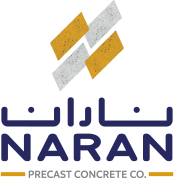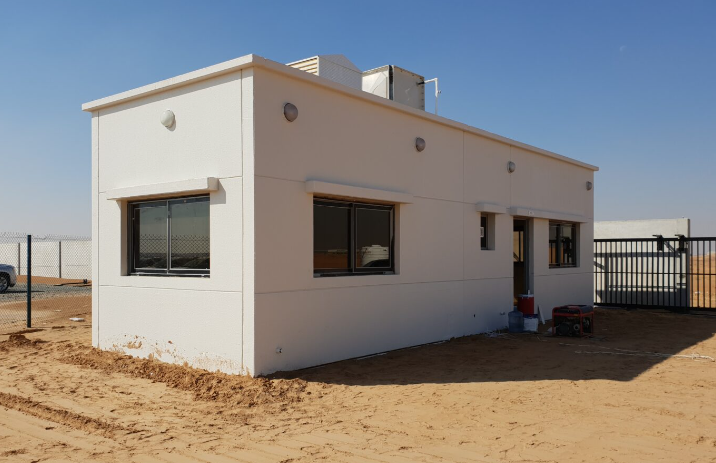Precast concrete construction solutions have revolutionized the way modern development is done. Now almost every building is made using precast concrete beams, columns, stairs, and especially the walls.
There are many benefits of using precast concrete walls in construction however the most important of all is the significant reduction in the time needed to complete a project.
The precast walls are panels that are made off-site in a factory by pouring concrete into a recyclable mould. After curing in a controlled environment these walls are shifted to the construction site where they are installed quickly.
This blog explores some of the most successful construction projects completed by the Naran Precast Concrete Co. in recent years. The article also delves into the benefits of using precast concrete boundary walls in any commercial or residential project so keep on reading till the end.
- Successful Projects Using Precast Walls
- Benefits of Using Precast Concrete Walls
- High Durability
- Enhanced Load Bearing Capacity
- Versatility
- Reduction in Construction Time and Budget
- Improved Aesthetics
- Harsh Weather & Fire Resistance
Successful Projects Using Precast Walls
Following are just a few examples of projects where Naran Precast Concrete Co. has provided their clients with premium quality precast concrete wall solutions.
| Client | Project |
| ADNOC Petrol Station, Amana | Boundary Walls |
| Abu Hashid | Boundary Walls |
| CRC Villanova | Boundary Walls |
| Children Park, Government of Sharja0068 | Boundary Walls |
| Orion Contracting LLC | Boundary Walls |
| HH Beach Villa | Boundary Walls |
| Abraj Construction | Boundary Walls |
| IMDAD | Boundary Walls |
| Diyar Ajman General Contracting | Boundary Walls |
| Speed House Contracting | Boundary Walls |
Following are some common features of the precast concrete walls used in the above projects
- The use of precast walls in these projects resulted in faster project completion while causing minimum disruption to the on-site workers as well as the local community.
- The precast concrete walls used in these projects ensured high durability in the face of extreme weather conditions, fires, and pest infestations.
- The walls used in these projects showed greater design customization flexibility. This allowed the finished walls to blend right into the structure.
- The precast concrete walls exhibit a higher level of uniformity as well as consistency in quality.
- The walls used in these projects ensured enhanced safety and security of the buildings.
Benefits of Using Precast Concrete Walls
Here are the main benefits of using precast concrete walls in your upcoming construction projects
1. High Durability
Precast concrete is prepared under extremely controlled conditions. After preparation of the walls, they are tested for load-bearing capacity, corrosion resistance, and other durability factors.
This ensures the precast component that arrives at the construction site is extremely sturdy and well-prepared. On the other hand, it is not possible to assess the strength of the concrete walls that are poured on-site. This makes these a less reliable option than precast concrete walls.
2. Enhanced Load Bearing Capacity
You can install precast concrete walls above or below ground and they will last you a lifetime owing to their great load-bearing ability. Some of these walls are reinforced with bars which further enhance their load-bearing capacity.
The construction of precast concrete walls involves careful planning and testing. This ensures the walls are able to do well for the application that they are intended for.
3. Versatility
The best part about the precast concrete walls is the freedom they give you in terms of design, size, and shape. No matter the project requirement, you can create very precise precast structures that will fit right in.
After taking into consideration things like the mechanical features of the shape of the concrete walls and its load-bearing capacity, you can pour concrete in the right amounts so that the final product not only gives you a better look but enhanced durability as well.
4. Reduction in Construction Time and Budget
Since precast concrete walls are prepared off-site, it allows other engineering and construction work to resume unhampered. Labors can work on other parts of the building and once the walls arrive they can quickly install these.
By eliminating the need to cast concrete on the site, precast concrete walls also ensure the number of labourers is reduced. This saves so many construction costs while ensuring the project is finished way before the actual deadline.
5. Improved Aesthetics
You can combine different pigments, types of cement, and aggregates when creating precast concrete walls to create components that blend well with the surroundings.
When creating concrete walls your main concern is to ensure the whole building appears consistent and in harmony. Precast concrete gives you limitless design options to choose from. This way you can easily get the walls that suit the vibe you wish to create indoors.
6. Harsh Weather & Fire Resistance
Precast concrete walls are a great choice in urban construction projects owing to their high weather and fire resistance. These structures are immune to fires, heavy rainstorms, and intense sunlight.
This makes precast concrete walls a much safer and more reliable solution for all types of construction projects.
Conclusion
Precast concrete walls have captured the attention of developers across the globe for their versatility and cost-effectiveness. By using these walls, it is possible to minimize on-site injury risks as well as potential roadblocks that may halt other construction processes while the concrete is being poured.
As precast concrete walls are prepared off-site it reduces the number of laborers needed on the actual construction site which improves the workflow as well as reduces costs.
This makes the construction processes much more efficient and the final output is always much better than you expect. Visit Naran Precast Concrete Co. to get the best precast concrete solutions for construction projects of all types.

